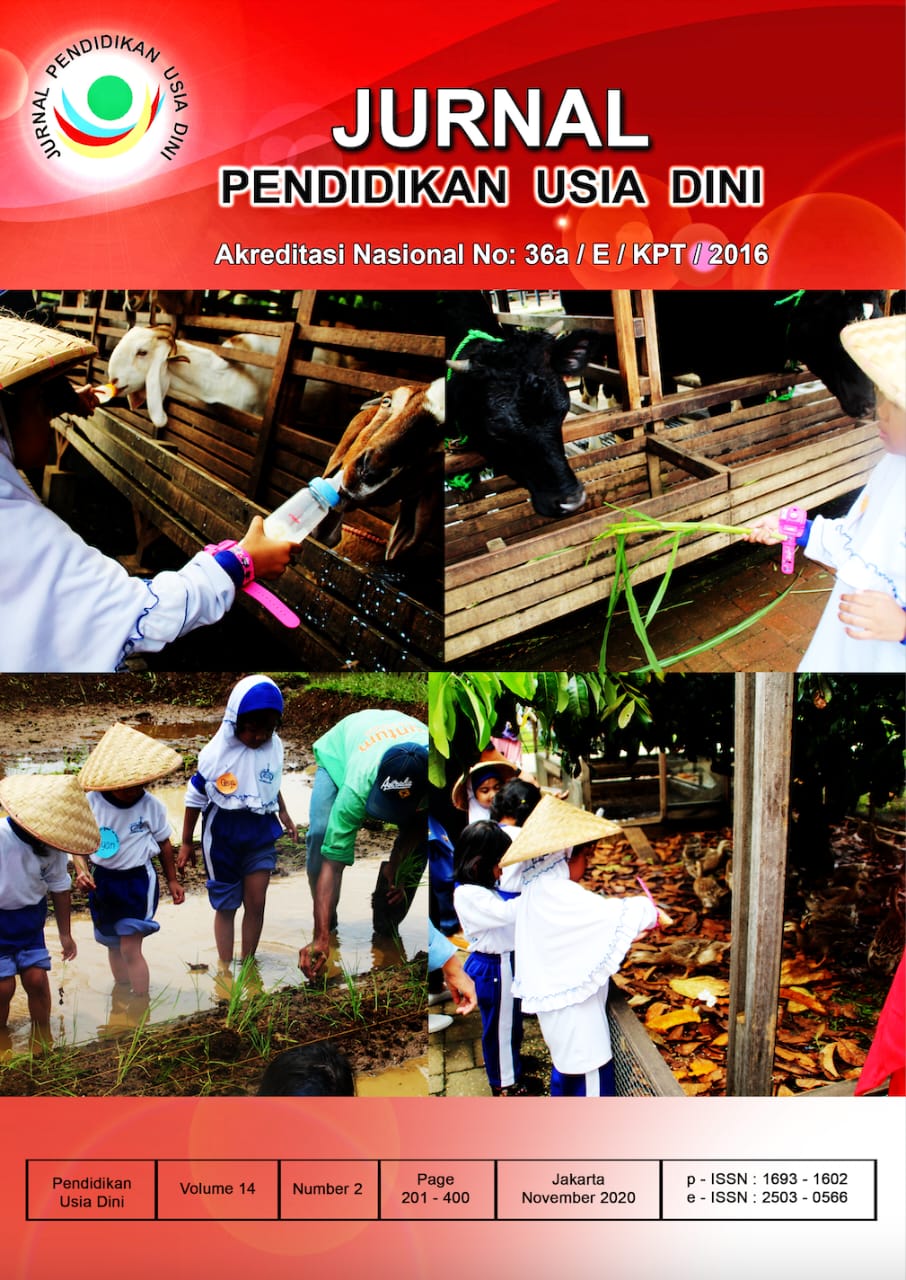Mother's Perspective About Using the Gadget Safeness for Children
DOI:
https://doi.org/10.21009/JPUD.142.09Abstract
The rapid development of technology makes it easier for mothers to provide stimulation related to growth and development using gadgets. However, parental knowledge is needed about the safe limits of using a gadget in early childhood. This study aims to determine the perspective and behavior of mothers about the use of gadgets in toddlers. The method used is quantitative research with a cross-sectional approach. The participants of this study were thirty-one mothers who have early childhood and who are empowering family welfare. The inclusion criteria were mothers who agreed to be respondents, the exclusion criteria for mothers who did not have gadgets. This study uses a questionnaire measurement instrument for data collection. Data analysis was performed univariate and bivariate using the chi-square test. The results of the study concluded that the mother's knowledge regarding the safety of using a gadget was still lacking, with a value of around 54.8%, while the mother's behavior related to the same thing was better, which was around 58.1%. The relationship test shows that there is a strong enough relationship between maternal knowledge and maternal behavior in introducing or using gadgets in toddlers.
Keywords: Early Childhood, Mother Perspective, Gadget Safeness
References
Appel, M. (2012). Are heavy users of computer games and social media more computer literate? Computers and Education, 59(4), 1339–1349. https://doi.org/10.1016/j.compedu.2012.06.004
Bandura, A. (1977). Social learning theory. Prentice-Hall.
Cingel, D. P., & Krcmar, M. (2013). Predicting Media Use in Very Young Children: The Role of Demographics and Parent Attitudes. Communication Studies, 64(4), 374–394. https://doi.org/10.1080/10510974.2013.770408
Connell, S. L., Lauricella, A. R., & Wartella, E. (2015). Parental Co-Use of Media Technology with their Young Children in the USA. Journal OfChildren and Media, 9(1), 5–21. https://doi.org/10.1080/17482798.2015.997440
Haines, J., O’Brien, A., McDonald, J., Goldman, R. E., Evans-Schmidt, M., Price, S., King, S., Sherry, B., & Taveras, E. M. (2013). Television Viewing and Televisions in Bedrooms: Perceptions of Racial/Ethnic Minority Parents of Young Children. Journal of Child and Family Studies, 22(6), 749–756. https://doi.org/10.1007/s10826-012-9629-6
Jones, I., & Park, Y. (2015). Virtual worlds: Young children using the internet. Young children and families in the information age. Educating the young child (Advances in theory and research, implications for practice) (I. K. Heider & J. M. Renck (eds.); Volume 10). Springer.
Lauricella, A. R., Wartella, E., & Rideout, V. J. (2015). Young children’s screen time: The complex role of parent and child factors. Journal of Applied Developmental Psychology, 36, 11–17. https://doi.org/10.1016/j.appdev.2014.12.001
Livingstone, S, Görzig, A., & Ólafsson, K. (2011). Disadvantaged children and online risk. http://eprints.lse.ac.uk/39385/
Livingstone, Sonia, Mascheroni, G., Dreier, M., Chaudron, S., & Lagae, K. (2015). How parents of young children manage digital devices at home: The role of income, education and parental style (Issue September).
Livingstone, Sonia, Ólafsson, K., Helsper, E. J., Lupiáñez-Villanueva, F., Veltri, G. A., & Folkvord, F. (2017). Maximizing Opportunities and Minimizing Risks for Children Online: The Role of Digital Skills in Emerging Strategies of Parental Mediation. Journal of Communication, 67(1), 82–105. https://doi.org/10.1111/jcom.12277
M, S. (2017). The Impact of using Gadgets on Children. Journal of Depression and Anxiety, 07(01), 1–3. https://doi.org/10.4172/2167-1044.1000296
Marsh, J., Hannon, P., Lewis, M., & Ritchie, L. (2017). Young children’s initiation into family literacy practices in the digital age. Journal of Early Childhood Research, 15(1), 47–60. https://doi.org/10.1177/1476718X15582095
Mifsud, C. L., & Petrova, R. (2017). Young Children (0-8) and Digital Technology. In JRC Science and Policies Reports.
Nevski, E., & Siibak, A. (2016). The role of parents and parental mediation on 0–3-year olds’ digital play with smart devices: Estonian parents’ attitudes and practices. Early Years, 36(3), 227–241. https://doi.org/10.1080/09575146.2016.1161601
Nikken, P. (2017). Implications of low or high media use among parents for young children’s media use. Cyberpsychology, 11(3 Special Issue). https://doi.org/10.5817/CP2017-3-1
Nikken, P., & de Haan, J. (2015). Guiding young children’s internet use at home: Problems that parents experience in their parental mediation and the need for parenting support. Cyberpsychology, 9(1). https://doi.org/10.5817/CP2015-1-3
Piotrowski, J. (2017). Media exposure during infancy and early childhood: The effect of content and context on learning and development. In I. R. Barr & D. Linebarger (Eds.), The parental media mediation context of young children’s media use.(pp. 205–219). Springer International Publishing.
Plowman, L., Stevenson, O., Stephen, C., & McPake, J. (2012). Preschool children’s learning with technology at home. Computers and Education, 59(1), 30–37. https://doi.org/10.1016/j.compedu.2011.11.014
Rasmussen, E. E., Shafer, A., Colwell, M. J., White, S., Punyanunt-Carter, N., Densley, R. L., & Wright, H. (2016). Relation between active mediation, exposure to Daniel Tiger’s Neighborhood, and US preschoolers’ social and emotional development. Journal of Children and Media, 10(4), 443–461. https://doi.org/10.1080/17482798.2016.1203806
Smahelova, M., Juhová, D., Cermak, I., & Smahel, D. (2017). Mediation of young children’s digital technology use: The parents’ perspective. Cyberpsychology, 11(3 Special Issue). https://doi.org/10.5817/CP2017-3-4
Troseth, G. L., Strouse, G. A., & Russo Johnson, C. E. (2017). Early Digital Literacy: Learning to Watch, Watching to Learn. In Cognitive Development in Digital Contexts. Elsevier Inc. https://doi.org/10.1016/B978-0-12-809481-5.00002-X
Vaala, S. E. (2014). The Nature and Predictive Value of Mothers’ Beliefs Regarding Infants’ and Toddlers’ TV/Video Viewing: Applying the Integrative Model of Behavioral Prediction. Media Psychology, 17(3), 282–310. https://doi.org/10.1080/15213269.2013.872995
Zaman, B., & Mifsud, C. L. (2017). Editorial: Young children’s use of digital media and parental mediation. Cyberpsychology, 11(3 Special Issue), 9. https://doi.org/10.5817/CP2017-3-xx
Downloads
Published
How to Cite
Issue
Section
License
JURNAL PENDIDIKAN USIA DINI work is licensed under a Creative Commons Attribution 4.0 International License. (http://creativecommons.org/licenses/by/4.0/)





